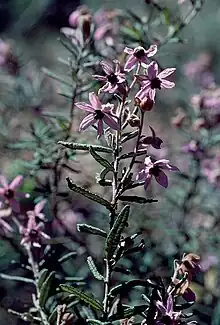Guichenotia angustifolia
Guichenotia angustifolia is a species of flowering plant in the family Malvaceae and is endemic to the south-west of Western Australia. It is an erect, prostrate or climbing shrub with hairy young growth, hairy, oblong to linear leaves and pink to mauve flowers.
| Guichenotia angustifolia | |
|---|---|
 | |
| Scientific classification | |
| Kingdom: | Plantae |
| Clade: | Tracheophytes |
| Clade: | Angiosperms |
| Clade: | Eudicots |
| Clade: | Rosids |
| Order: | Malvales |
| Family: | Malvaceae |
| Genus: | Guichenotia |
| Species: | G. angustifolia |
| Binomial name | |
| Guichenotia angustifolia | |
| Synonyms[1] | |
| |
Description
Guichenotia angustifolia is an erect, prostrate or climbing shrub that typically grows to 0.15–1.5 m (5.9 in – 4 ft 11.1 in) high and 1.5–2 m (4 ft 11 in – 6 ft 7 in) wide, its young branches densely covered with star-shaped hairs. The leaves are oblong to linear, 8–40 mm (0.31–1.57 in) long and 1–4 mm (0.039–0.157 in) wide on a petiole 1–3 mm (0.039–0.118 in) long with lance-shaped stipules 1–12 mm (0.039–0.472 in) long at the base. Both surfaces of the leaves are covered with star-shaped hairs. The flowers are borne singly, in pairs or in cymes on a peduncle 10–40 mm (0.39–1.57 in) long, each flower or pair on a pedicel 6–12 mm (0.24–0.47 in) long, with bracts 2–7 mm (0.079–0.276 in) long and egg-shaped bracteoles 2–4 mm (0.079–0.157 in) long at the base. There are five, petal-like sepal lobes and five small red petals. Flowering occurs from July to November and the fruit is a papery capsule 7 mm (0.28 in) in diameter.[2][3]
Taxonomy and naming
This species was first formally described in 1846 by Nikolai Turczaninow who gave it the name Ditomostrophe angustifolia in the Bulletin de la Société Impériale des Naturalistes de Moscou, from specimens collected by James Drummond.[4][5] In 1917, George Claridge Druce transferred the species to Guichenotia as G. angustifolia in the supplement to The Botanical Exchange Club and Society of the British Isles Report for 1916.[6] The specific epithet (angustifolia) means "narrow leaved".[2][7]
Distribution and habitat
Guichenotia angustifolia usually grows in shrubland from near Perth to near Brookton and Northampton in the Avon Wheatbelt, Geraldton Sandplains and Jarrah Forest bioregions of south-western Western Australia.[2][3]
Conservation status
Guichenotia angustifolia is listed as "not threatened" by the Government of Western Australia Department of Biodiversity, Conservation and Attractions.[2][3]
References
- "Guichenotia angustifolia". Australian Plant Census. Retrieved 18 May 2023.
- Blake, Trevor L. (2021). Lantern bushes of Australia ; Thomasias & allied genera : a field and horticultural guide. Victoria: Australian Plants Society, Keilor Plains Group. pp. 212–213. ISBN 9780646839301.
- "Guichenotia angustifolia". FloraBase. Western Australian Government Department of Biodiversity, Conservation and Attractions.
- "Ditomostrophe angustifolia". Australian Plant Name Index. Retrieved 18 May 2023.
- Turczaninow, Nikolai (1846). "Generum adhuc non descriptorum, adkectis descriptionibus nonnullarum specierum Byttneriacearum". Bulletin de la Société Impériale des Naturalistes de Moscou. 19 (2): 499. Retrieved 18 May 2023.
- "Guichenotia angustifolia". APNI. Retrieved 18 May 2023.
- Sharr, Francis Aubi; George, Alex (2019). Western Australian Plant Names and Their Meanings (3rd ed.). Kardinya, WA: Four Gables Press. p. 133. ISBN 9780958034180.